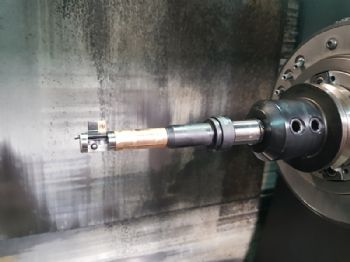
By calling in a tooling specialist from Chessington-based Mollart Engineering Ltd (
www.mollart.com), who recommended using a Steiner Autofacer, precision sub-contractor Lunn Engineering Co has been able to incorporate ‘back counterboring’ operations into fully automatic production cycles, significantly reducing production lead times when machining cast-iron flywheel housings for off-road vehicles.
Previously, access constraints meant that some of the counterbored features had to be produced on a second machine, necessitating additional work handling and extended lead times.
Works foreman Martin Sharpe said: “We have produced some 1,400 of these components on our horizontal twin-pallet machining centre, which was installed specifically to produce them.
"However, we were having to run an additional operation on a horizontal borer located in another area of the factory, just to produce three counterbore features that were very difficult to access, as they were set back behind the housing’s main location flange.

“The introduction of the Steiner Autofacer has allowed us to reduce three operations down to two fully automatic production cycles involving A and B fixtures on the twin-pallet HMC — considerably reducing lead times, along with
the time taken for work handling, setting and inspection.
As a result, we have been able to concentrate production and sub-assembly of the flywheel housing in one area of the works. Moreover, eliminating one of the previous relocations means we have greater control over quality.”
Mr Sharpe says Lunn Engineering is also benefitting from longer tool life, compared with back counterboring on
a horizontal borer.
“We are now achieving 120 counterbores per insert corner, thanks to the inherent rigidity of both the machining centre and the Steiner Autofacer.”
Lunn Engineering produces two types of housing for two- and four-wheel drive off-road vehicles at a rate of 15 per week.
After machining, the housings are cleaned, painted and assembled, which includes the insertion of bearings.
When Mollart’s tooling specialist went to Lunn Engineering to assess the machining of the flywheel housings, he found that three counterbores could only be produced by back counterboring through 18mm-diameter holes.
These are drilled through from the outer face of the housing, directly opposite the main flange face that is used for initial first-operation location on the fixture.
It was this main flange that partially covered each counterbore position that is set back inside the well of the housing.
Adding to the counterboring problems was a steep draft angle around each of these features, which meant that any back counterboring tool had to cope with a progressive material build-up and a variable interrupted cut.
Indeed, it was this draft angle that had led to failed attempts to back counterbore using another make of tool; the problem had been excessive tool chatter and inconsistent tool life.
Mr Sharpe and the Mollart engineer worked together to develop the process using the Steiner Autofacer, which is being run at 810rev/min at a feed of 0.04mm/rev.
The tool is activated by contact with the datum face of the workpiece, as it passes through the previously drilled 18mm holes.
Each drilled hole acts as a support for a pilot bearing on the Autofacer tool (this is positioned behind the insert pocket on the body of the tool).
Reversing the machine spindle causes an internal friction clutch to mechanically open the cutter blade and lock it to the required 36mm diameter.
The tool is then fed in reverse back into the casting. When a programmed depth of 32.5 ±0.05mm from the machined datum face is reached, the tool is fed forward clear of the counterbore, during which a cone positively drives the cutter blade to its closed position into the tool head before it is automatically withdrawn back down the 18mm drilled hole. It takes just 6min 20sec to complete the three holes.
Following the success of the Autofacer, Mollart is now working on further process improvements, including replacing twist drills used for specific deep holes in the two housing types with Botek gundrills.
These will provide improved efficiency and the ability to achieve geometrical tolerances within ±0.2mm.